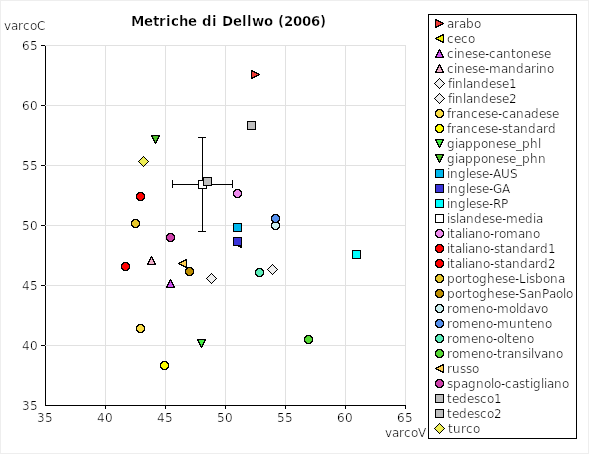The varcos
 Various authors used the metrics proposed by Ramus, Nespor & Mehler (1999) on more data and it soon become apparent that ΔC and above all ΔV are extremely sensible to certain variables such as speech rate. The interaction between the deltas and speech rate has been accurately studied by Dellwo & Wagner (2003), who hint at the possibility of using a new metric, the varcos, in order to normalize these effects: the values of the deltas are divided by the mean duration of (vocalic or consonantal) intervals, then multiplied by 100:
Various authors used the metrics proposed by Ramus, Nespor & Mehler (1999) on more data and it soon become apparent that ΔC and above all ΔV are extremely sensible to certain variables such as speech rate. The interaction between the deltas and speech rate has been accurately studied by Dellwo & Wagner (2003), who hint at the possibility of using a new metric, the varcos, in order to normalize these effects: the values of the deltas are divided by the mean duration of (vocalic or consonantal) intervals, then multiplied by 100:

Expectations are of course similar to those for the deltas, so languages traditionally described as syllable-timed should present lower values of varcoC and varcoV than stress-timed languages. This idea is then reproposed and elaborated by Dellwo (2006).
Members of the staff of the Laboratory of Experimental Phonetics of Turin tried to compute these parameters on a broader sample of languages; the results are shown in the charts. The data consist of the narrative The North Wind and the Sun translated into various languages and read by professional or standard speakers (we have used some of the illustrations of the Handbook of the IPA and of the Journal of the IPA, but many samples have been recorded in our laboratory). The recordings have been accurately segmented and annotated independently by Antonio Romano and Paolo Mairano and the final results consist of the average of the values obtained by the two authors. Every dot in the chart corresponds to one speaker (except for Icelandic, for which we have 1 dot for 10 speakers to avoid confusion - the error bar indicates the standard deviation between the results obtained for each of the 10 speakers). The values of the correlates have been computed with the help of Correlatore, with which we have also built the charts.
A detailed discussion of the results can be found in our publications (see the bibliography below). However, it should be noticed that languages traditionally considered as syllable-timed (Italian, French, Spanish, ...) are roughly situated in the lower left corner of the chart (with low values of both varcoC and varcoV), whereas languages traditionally considered as stress-timed (English, German, ...) are roughly distributed in the upper right corner of the chart (with high values of both varcoC and varcoV).
Essential bibliography
- Dellwo, V. (2006) Rhythm and speech rate: a variation coefficient for deltaC. In Karnowski P. & Szigeti, I. (ed.) Language and language processing. Frankfurt am Main: Peter Lang, 231-241.
- Dellwo, V. & Wagner, P. (2003) Relations between language rhythm and speech rate. Proc. of the International Congress of Phonetic Science, Barcelona, 471-474.
HTML, CSS and design by Paolo Mairano